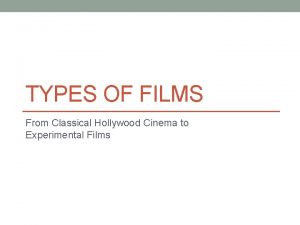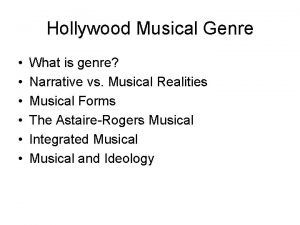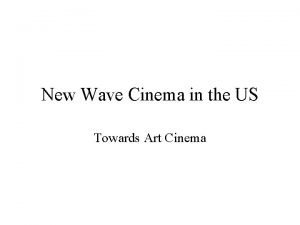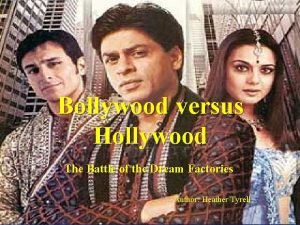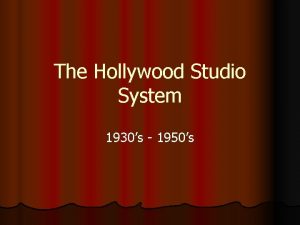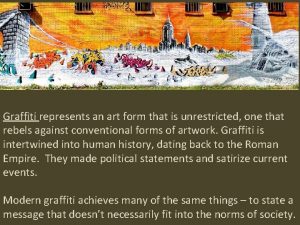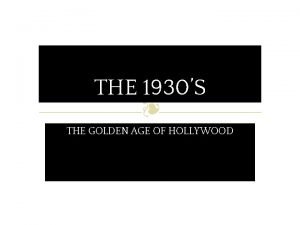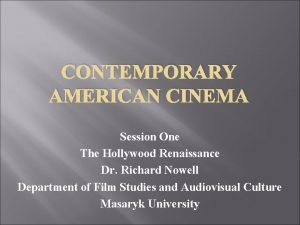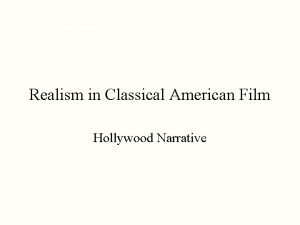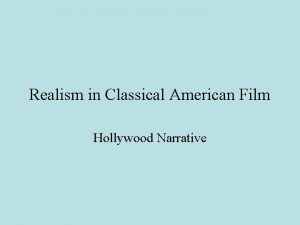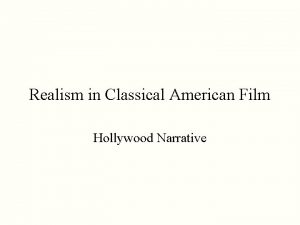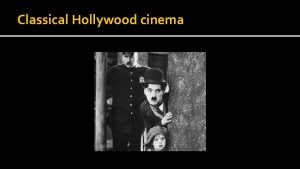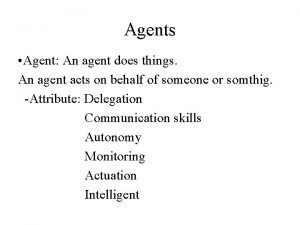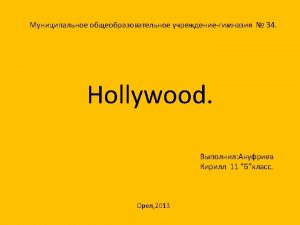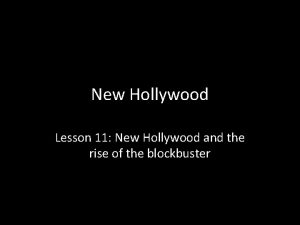Classical Hollywood Narrative active agent goaloriented protagonist psychologisch





































- Slides: 37

Classical Hollywood Narrative ¡ active agent /goal-oriented protagonist ¡ psychologisch motivierte Figuren ¡ Zwei Handlungsstränge § Suspense § Love Story ¡ Zufall/Deus ex machina nicht erwünscht ¡ Deadlines PD Mag. Dr. Claus Tieber 1

Ton und Musik im Stummfilm • Versuche der technischen Synchronisierung • Erzähler • Klavier • Salonorchester • gr. Orchester

Stummfilmmusik • Mechanische Musik • „Improvisation“ • Cue Sheets • Handbücher, Sammlungen • Scores

Musik im Stummfilm • • • populäre Songs und Tunes populäre Stücke/Melodien aus dem klassischen Repertoire oft textgebunden

RKO • David Sarnoff • RCA (Radio Corporation of America) • sound on film • Photophone • Film Booking Office • Keith-Albee-Orpheum vaudeville houses • Radio-Keith-Orpheum - RKO

Big Five Agreement • MGM • Universal • First National • Paramount • Producers Distributing Corporation • act together in adopting sound systems • Western Electric sound on disc vs. RCA sound on film

Vitaphone • Vitaphone Shorts • Don Juan 1926 • 6. 10. 1927: Jazz Singer • The Lights of New York

Pre-Code Era bis 1934 • Black Friday 1929 Beginn der Wirtschaftskrise • 1933 Wahl FD Roosevelts, Beginn New Deal • Ende der Prohibition 1933

Umbrüche in der Filmindustrie • Finanzierung durch Wall Street • Producer Unit System • neue Drehbuchautoren • Production Code ab 1934

Big Five • Paramount • Loew‘s/MGM • 20 th Century Fox • Warner Bros. • RKO

Little Three • Universal • Columbia • United Artists

Independents • Samuel Goldwyn • David O. Selznick

National Industrial Recovery Act (NIRA) • Codes of Fair Competition • Gewerkschaften • Motion Picture Code • Zoning • wird 1935 aufgehoben, anti-Trust Kampagne folgt

Kinobesuch 1930 • 23. 000 Kinos • 400 Movie Palaces in cities of 50. 000 or more • these cities contained 35 % of the population or 43 million people • mainly in the large eastern states and in California • double feature • A picture ca. $ 400. 000 (Herstellungskosten) • B picture $ 50. 000 - 200. 000

B Pictures • 1930: 10% of theaters played double features • 1935: 75 % (at least part of the week) • 40 % exclusively

Foreign Markets • 1930 Hollywood 75 -80% • $200 mill in film rentals (275 total annual gross) • Subtitling • Dubbing • Foreign language versions

Genre • Produktion • Analyse • Rezeption

Altman: Film/Genre If it is not defined by the industry and recognized by the mass audience, then it can not be a genre, because film genres are by definition not just scientifically derived or theoretically constructed categories, but are always industrially certified and publicly shared. Altman, 16 18

Altman cont. Films often gain genre identity from similar detects and failures rather than from qualities and triumphs. The early history of film genres is characterized (…) not by a purposeful borrowing from a single pre-existing non-film parent genre, but by apparently incidental borrowing from several unrelated genres. 19

Altman cont. Even when a genre already exist in other media, the film genre of the same name cannot simply be borrowed from non-film sources, it must be recreated. Films are always available for redefinition 20

Altman Genres begin as reading positions established by studio personnel acting as critics Creation of a reading position – reinforcement – broad industry acceptance of the proposed reading position and genre 21

Altman By assaying and imitating the money-making qualities of their most lucrative films, studios seek to initiate film cycles that will provide successful, easily exploitable models associated with a single studio. Cycle – genre Genrefication as process: new material, new approach 22

Wulff Sets kultureller Konventionen zur Routine gewordene Erzählstrategien im Umgang mit "ideologischen Spannungen" und Konflikten breites Spektrum ideologischer Funktionen ökonomisches Prinzip und zugleich film-kulturelle Größe Serialisierung 23

Wulff Standardisierung kommunikative Versprechen jeweils spezifischen Erwartungshorizont bestimmte Rezeptionshaltung feste Verabredung oder Übereinkunft zwischen Produzent und Rezipient zu verstehen Flexibilität 24

Wulff Spiel mit Klischees, Mustern und Stereotypisierungen Genre ist ein offen-texturiertes Konzept und erweist sich gerade in dieser Unbestimmtheit im Sprechen über Film als nützlich 25

Genres 1930 er Jahre • Musical • Gangsterfilm • Screwball Comedy • Social Problem Films

Musical • 1928: 60 Filmmusicals • 1929: one in four films in production

Musical Backstage Musical (42 nd Street) • • Operetta Musical (The Love Parade) • Integrated Musical • fairy tale • Show Musical • Folk Musical

Jazz Singer

Busby Berkeley: 42 nd Street

operetta musicals

Social Problem Films I Was a Fugitive from a Chain Gang (1932)

Gangsterfilm: Little Caesar, Public Enemy, Scarface

Universal Horror

Screwball Comedy It Happend One Night (1934)

Screwball Comedy • Freizeit; die meisten der Figuren sieht man nicht bei der Arbeit • Kindhaftigkeit der Charaktere • urbane Spielorte • apolitische Figuren • Frustration der männlichen Hauptfigur. Oppositionen.

Prestige Picture • big budget • based in presold property • top stars • special effects
 Continuity editing definition
Continuity editing definition Classical hollywood cinema characteristics
Classical hollywood cinema characteristics Oxidizing vs reducing agent
Oxidizing vs reducing agent Peas for interactive english tutor
Peas for interactive english tutor Electrode potential table
Electrode potential table Reducing agent vs oxidizing agent
Reducing agent vs oxidizing agent Agent function vs agent program
Agent function vs agent program Capital of hollywood
Capital of hollywood Etds universal studios hollywood
Etds universal studios hollywood Where is the hollywood sign
Where is the hollywood sign West hollywood rso
West hollywood rso Hollywood
Hollywood Hollywood music genre
Hollywood music genre Hollywood 1977
Hollywood 1977 Benzedrine inhaler history
Benzedrine inhaler history Dream factory hollywood
Dream factory hollywood Hollywood versus bollywood
Hollywood versus bollywood The hollywood studio system in the 1930s and 1940s
The hollywood studio system in the 1930s and 1940s Prensa rosa española
Prensa rosa española Hollywood africans
Hollywood africans Inhalt des films
Inhalt des films Movie capital of the world
Movie capital of the world St helen’s smelting co v tipping (1865)
St helen’s smelting co v tipping (1865) Golden age of hollywood 1930s
Golden age of hollywood 1930s How was the hollywood ten affected by the accusations
How was the hollywood ten affected by the accusations Hollywood vs history
Hollywood vs history Hollywood renaissance films
Hollywood renaissance films Hollywood
Hollywood And or boolean
And or boolean Primary active transport and secondary active transport
Primary active transport and secondary active transport Primary active transport vs secondary active transport
Primary active transport vs secondary active transport Fictional narrative writing
Fictional narrative writing Difference between narrative and story
Difference between narrative and story Dynamic chracter
Dynamic chracter Inference in the most dangerous game
Inference in the most dangerous game Mr.jones animal farm
Mr.jones animal farm Protagonist antagonist
Protagonist antagonist Hills like white elephants full text doc
Hills like white elephants full text doc

